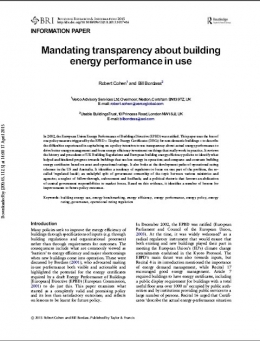Mandating transparency about building energy performance in use, Building Research & Information
In 2002, the European Union Energy Performance of Buildings Directive (EPBD) was ratified. This paper uses the lens of one policy measure triggered by the EPBD – Display Energy Certificates (DECs) for non-domestic buildings – to describe the difficulties experienced in capitalizing on a policy intention to use transparency about actual energy performance to drive better energy management and focus energy efficiency investment on things that really work in practice. It reviews the history and precedents of UK Building Regulations and European building energy efficiency policies to identify what helped and hindered progress towards buildings that use less energy in operation; and compares and contrasts building energy certificates based on asset and operational ratings. It also looks at the development paths of operational rating schemes in the US and Australia. It identifies a tendency of regulators to focus on one part of the problem, the so-called ‘regulated loads'; an unhelpful split of government ownership of the topic between various ministries and agencies; a neglect of follow-through, enforcement and feedback; and a political rhetoric that favours an abdication of central government responsibilities to market forces. Based on this evidence, it identifies a number of lessons for improvements to future policy outcomes.

